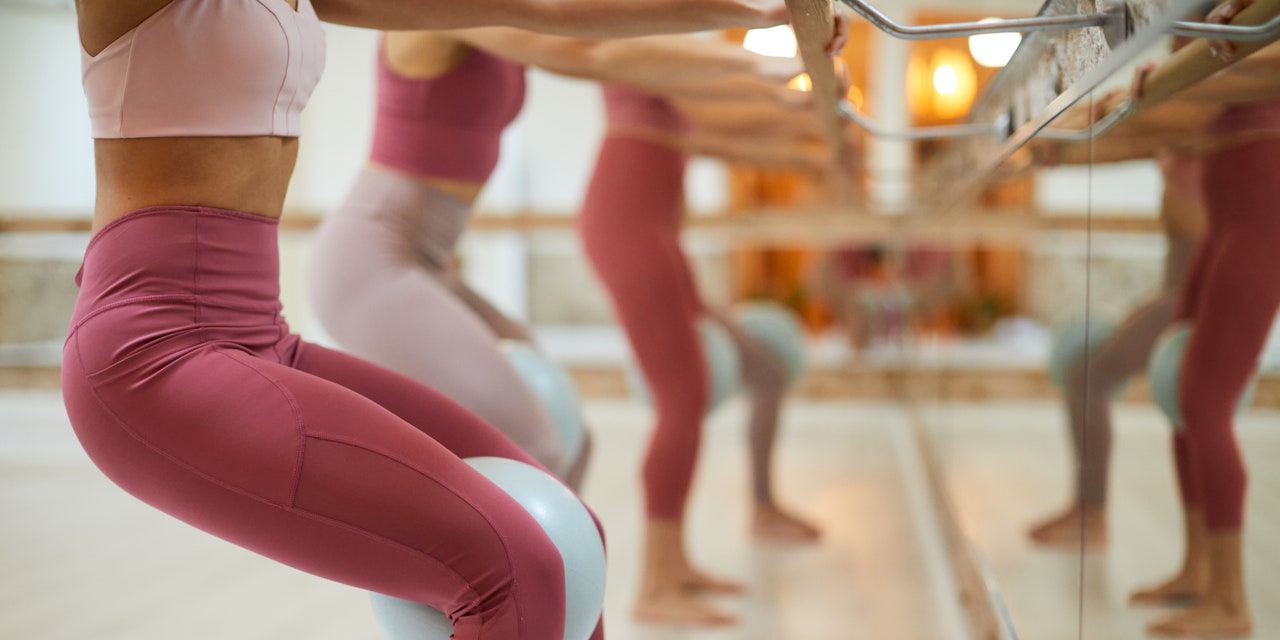Does Barre ‘Count’ as Strength Training or Is It More About Flexibility?

All products are independently selected by our editors. If you buy something, we may earn an affiliate commission.
Hop into any barre class and your muscles will quickly start to feel it: As you pulse to the beat of the booming playlist, it’s pretty darn common to get “the shakes,” where your body starts trembling from the strain of seemingly endless repetitions. It’s a similar feeling to what you might get from a tough lifting workout.
But do those burning, quivering muscles mean that barre actually “counts” as strength training—even if you never pick up anything heavier than a three-pound weight? We asked barre experts to break down exactly how this popular ballet-inspired workout affects our muscles, and the best way to fit it in with the rest of your exercise routine.
So what kind of strength can barre build?
The current trendiness of barre can make it seem like a newfangled workout, but it actually dates back decades ago. The regimen centers around traditional strength training movements like lunges and squats, but gives most of them a ballet-inspired twist, like turnout (outward rotation of the legs) or demi-pointe (raising up onto the balls of your feet). Some exercises also use a classic ballet barre to help you balance.
Traditionally, most barre moves don’t go through your full range of motion like you would in a typical lifting session. For instance, if you were doing a lunge, you’d normally bend all the way down until your one leg is parallel to the floor, then you’d stand all the way up before you do it all over again. Barre is different: “We go to that end range of motion, so you’re sinking down into a lunge, and then you’re doing little pulses,” exercise physiologist Rachelle Reed, PhD, an instructor at PureBarre, tells SELF.
This doesn’t mean it’s any easier, though. The challenge comes from doing a ton of repetitions of these tiny contractions—sometimes for minutes at a time. “You’re in it longer than what you would see in traditional strength training,” Lisa Schale-Drake, online lead instructor at Barre3, tells SELF. That’s possible because, instead of lifting super heavy weights through big ranges, you’re moving just your own bodyweight, or maybe light dumbbells, ankle/wrist weights, or resistance bands in small micro-movements.
These mini pulses mimic what you’d get out of an isometric exercise, where you just keep your body still in one challenging spot. “It’s almost like holding a plank for every major muscle group in your body,” Shannon Reznik, a master teacher trainer at PureBarre, tells SELF. These kinds of isometric movements build muscular endurance, or our muscles’ ability to keep firing over an extended period.
“This is really focusing much more on your slow-twitch fibers,” Sarah Patterson, CPT, product manager of strength classes at Barre3, tells SELF. These are the fibers designed for the long haul—they don’t generate a ton of power, but they can keep at it for quite some time. “These have a much higher resistance to fatigue and they also recover really, really quickly,” Patterson says. They’re what our bodies rely on for low- or moderate-intensity activities like hiking, low-key cycling or, ya know, day-to-day life like staying upright when you’re just standing around.
However, you won’t win any Strongman Challenges just by taking barre class.
If you consider strength training as anything that makes your muscles stronger, sure, barre can fit the bill. Although there hasn’t been much research done on barre specifically, there is evidence that this kind of high repetition/low weight exercise can be just as effective for growing muscle as heavy lifting—as long as you keep going close to the point of what exercise scientists call “failure,” where the last couple of reps feel nearly impossible to eke out.
But if your goal is to maximize your strength, barre isn’t really the best strategy. By not lifting any heavy weights, you’re limiting the gains you could make because you’re not training your muscles to produce the force and power it takes to move bigger loads. And in the group class format of a barre workout, it can be tricky to systematically increase the challenge over time with the kind of tailored progressive overload strategy that’s known to boost strength most effectively. “The muscle fibers are only adapting to the stimulus that you’re giving them,” Dr. Reed says. “At a certain point, you’re just maintaining rather than continuing to accrue more adaptation.”
That said, many barre studios are evolving to enhance the strength benefits of the workout. For instance, Dr. Reed says most instructors at various barre studios now incorporate the full ranges of motion during some exercises to supplement all that isometric work—meaning they’ll now include eccentric and concentric contractions (when the muscles are activated while lengthened or shortened, respectively) for greater strength gains. And many barre studios now have strength-focused classes that use up to 15- or 20-pound weights.
But there are other solid reasons to check out barre too.
Of course, stronger muscles aren’t the only reason to work out. Other aspects of your fitness can get a bump from barre class too.
Two of the biggest benefits harken back to barre’s balletic roots: flexibility and balance. Right alongside those strength exercises, most barre classes incorporate stretches like bending over your legs to lengthen the hamstrings. And barre is typically done in thin, grippy socks, which means you can feel the floor with the soles of your feet; Dr. Reed says this can help improve our proprioception, or the feedback between our brain and body that’s essential for balance. Add in the fact that many of the movements are done with your heels raised while others have you standing on just one leg, and you’ve got a major balance booster.
Schale-Drake says she actually sees barre’s balance challenges as functional core training. “We rarely lie on the floor and just do crunches—that’s not very functional. But standing on one leg, switching from a lunge to a knee lift, or stepping out wide to one side, these are all training for life,” she says.
That booming playlist in barre class also has its benefits. Because all the movements are set to a musical beat, it can encourage you to push harder. “When you feel the music course through your body and you’re working in unison with people in the room, it just provides this intangible sense of energy,” Reznik says. It also just makes exercising more fun—which is actually a pretty important perk given that science shows we’re more likely to stick with workouts we actually like. “Enjoyment is the biggest predictor of long-term maintenance,” Dr. Reed says.
Barre can seamlessly slot into the rest of your workout routine.
Tempted to give barre a try? Fortunately, this workout is pretty easy to include alongside the rest of your weekly workouts: Barre doesn’t typically wear you out so much that you need multiple days to recover the way that you might with more intense strength training or high-impact workouts.
Plus it can benefit your fitness no matter where you’re coming from.
Pretty new to strength work? Barre workouts can be a fantastic entry point for heavier lifting. Schale-Drake says they train proper alignment and build endurance that can help you to eventually take on higher loads. “I say it’s foundational to supporting other activities that require a higher amount of resistance,” she says.
But that doesn’t mean you can’t benefit if you’re already a big lifter. “This is going to help you have better form, better core, better coordination, reduce your fatigue so you can go heavier and stronger and more powerful with your lifting,” Schale-Drake says.
For cardio fans looking to use barre to check off their strength training box, Dr. Reed recommends starting with one or two classes a week, then eventually working in more progressively overloading strength work (outside of class). She adds that barre is actually a popular cross-training option for runners since it improves balance and helps maintain muscle mass, but isn’t so strenuous that you can’t do a long run the next day.
No matter where you’re coming from or how you usually like to move, barre can help make your body more resilient. “[For] people who are looking to cross-train, improve their mobility, work on flexibility, work on balance, and just learn safe, strong exercise form,” Dr. Reed says, “adding barre into their routine could be a really good thing to consider.”
Related:
- Does Indoor Cycling ‘Count’ as Strength Training—or Is It Just Cardio?
- 10 Things to Know Before You Take Pilates Classes
- 17 Pilates Exercises That Really Work Your Core
Get more of SELF’s great fitness coverage delivered right to your inbox—for free.




